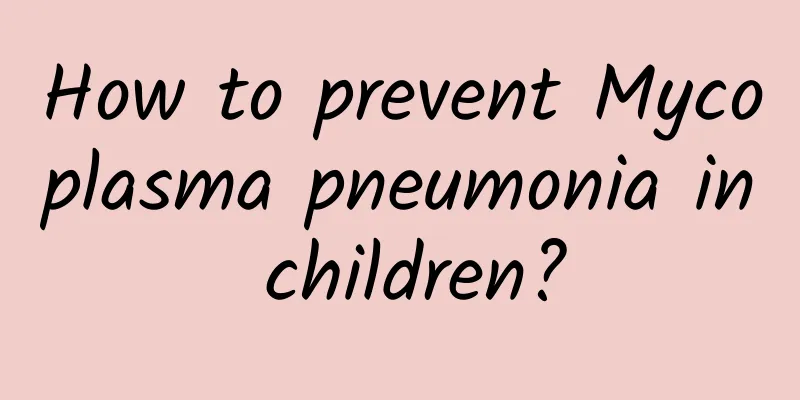How to prevent Mycoplasma pneumonia in children?

|
How to prevent Mycoplasma pneumonia in children? Cui Yanyan, Sun Tongwen, Department of Critical Care Medicine, The First Affiliated Hospital of Zhengzhou University Recently, "children with Mycoplasma pneumonia infection" has frequently been on the hot search list. The pediatric departments of major hospitals are overcrowded, and many parents are beginning to worry. How to prevent their children from being infected during the high-incidence period? What are the symptoms after a child is infected? How to provide scientific care and prevention? Today, we will reveal the secrets of childhood Mycoplasma pneumonia infection. Introduction to Mycoplasma pneumonia: Mycoplasma pneumonia is a lung inflammation caused by infection with Mycoplasma pneumoniae, which can affect the bronchi, bronchioles, alveoli and lung interstitium. The disease is concentrated in children aged 5 to 15 years. Most patients have a self-limiting disease with a natural course of about 10 to 14 days and an incubation period of 2 to 3 weeks. It can occur all year round, but usually in autumn and winter. Mycoplasma pneumoniae is a microorganism between viruses and bacteria, and is often classified as an "atypical pathogen" clinically. The sources of infection are mostly patients infected with Mycoplasma pneumoniae and pathogen carriers. The pathogen is mainly transmitted through respiratory droplets. Mycoplasma pneumoniae infection is often mixed with other bacteria, further aggravating the condition. Symptoms and manifestations of mycoplasma pneumonia: Symptoms of mycoplasma infection in children are similar to most respiratory diseases. Mycoplasma pneumoniae infection has a long incubation period, and clinical manifestations vary in severity, with fever and cough being the most common manifestations. Fever is mainly moderate to high fever, which can last for 2 to 3 weeks, and the body temperature is usually 38 to 39°C. In the early stage, there is a dry cough, and in the later stage, there is yellow or white sticky sputum, and occasionally blood in the sputum. Some children have wheezing symptoms, which can lead to bronchitis and pneumonia. Mycoplasma pneumoniae can also cause functional damage to other systemic organs outside the lungs, such as the digestive system, myocardium, liver, etc. Criteria for hospitalization of mycoplasma pneumonia: Persistent high fever 72 hours after treatment; presence of infection and poisoning symptoms; rapid progression of the disease and imaging, with multi-lobar infiltration; significant increase in CRP, LDH, D-dimer, and ALT, the earlier the onset, the more severe the condition; hypoxemia and dyspnea are difficult to relieve or progress after treatment; presence of underlying diseases, including asthma and primary immunodeficiency disease; delayed treatment with macrolide antibiotics. Nursing of Mycoplasma pneumonia: 1. Correct medication: Unlike bacteria, Mycoplasma pneumoniae lacks a cell wall, so the commonly used cephalosporins, penicillins and other drugs are ineffective against Mycoplasma pneumoniae. Currently, the first choice for the treatment of Mycoplasma pneumoniae infection is macrolide drugs, such as azithromycin and roxithromycin. However, after the child's body temperature returns to normal, the cough may continue for about 2 weeks. Each child's condition is different, and the type and dosage of medication will also be different, so you must follow the doctor's instructions. 2. Maintain appropriate indoor temperature and humidity: The child needs to rest in bed, keep the indoor air fresh and ventilated, open the window 2-3 times a day, each time for about 30 minutes. The indoor temperature is maintained at 20℃ and the humidity is about 60%. 3. Keep the airway clear: The child's oral, nasopharyngeal secretions should be cleared in time to maintain oral hygiene and airway patency. Ultrasonic atomization inhalation can be used to dilute the sputum in the oropharynx, making it easier for the child to cough it out. After atomization, the sputum can be coughed out, and at the same time, the back can be patted with appropriate strength and rhythm. The vibration of the patting back can loosen the sputum and make it fall off. 4. Fever care: Loosen the child's clothes, change the sweaty clothes in time, wipe the sweat with a hot towel, and keep warm. When the body temperature reaches above 38.5℃, physical cooling can be given according to the doctor's instructions, such as ice compress on the forehead, warm water bath, ice salt water enema, etc. Measure the body temperature again after 30 minutes and keep a record. If necessary, give antipyretics according to the doctor's instructions for drug cooling, and closely observe the efficacy of the medicine to prevent the body temperature from dropping suddenly to the point of collapse of the child. Sufficient water should be replenished in time to maintain water and electrolyte balance. 5. Dietary care: The diet should be as nutritious as possible, with high-calorie, high-vitamin, easily digestible foods. Eat small meals frequently, eat as little spicy food as possible, and eat more fresh fruits and vegetables such as green vegetables, bananas, apples, pears, etc. Prevention of Mycoplasma pneumonia: 1. Control the source of infection: People infected with Mycoplasma pneumoniae and carriers of the pathogen are the source of infection. Mycoplasma pneumoniae is highly contagious and has a long incubation period. It is contagious during the incubation period until the symptoms are relieved for several weeks. Therefore, when family members or people around are infected with Mycoplasma pneumoniae, children should minimize their contact with them. The school conducts morning inspections every day. When suspected sick children are found, timely measures are taken to send them to the hospital for treatment or let them rest at home, and the items used by the sick children are disinfected. Parents should do a good job of self-examination and self-control. They should insist on self-examination of their children before going to kindergarten and after returning home. If abnormalities are found, they should be observed at home or sent to the doctor for treatment in a timely manner. The children should be sent to kindergarten after they recover to avoid cross infection. 2. Cut off the transmission route: During the season of mycoplasma pneumonia, try not to take children to public places or crowded places. It is recommended that children wear masks except when they are outdoors. It is recommended to develop a good habit of washing hands frequently. It is recommended to use soap or hand sanitizer and wash hands under running water. 3. Protect susceptible groups: There is currently no vaccine to prevent Mycoplasma pneumoniae infection. After infection, there is no permanent immunity and there is a possibility of reinfection. Parents can start with good living habits such as maintaining adequate sleep, balanced nutrition, and proper exercise to increase children's ability to resist pathogens. When coughing or sneezing, cover your mouth and nose with a tissue or towel. Wash your hands after coughing or sneezing, and try to avoid touching your eyes, nose or mouth directly. Nowadays, children generally eat too little vegetables and too much meat. Many children with respiratory infections have constipation. Therefore, the primary task of parents is to keep their children in a healthy diet and improve their body immunity. Encourage children to strengthen physical exercise, have a regular work and rest schedule, and insist on having children participate in kindergarten sports activities and physical exercises on time every day to enhance their resistance to disease. The temperature changes greatly at present, and clothes should be gradually added or removed as the temperature changes. In short, to prevent Mycoplasma pneumoniae infection, you need to avoid gathering together, maintain personal hygiene habits, observe "cough etiquette", get enough sleep and have a balanced diet. At the same time, you should also pay attention to home cleanliness and hygiene, and keep the indoor air circulating. |
<<: [Doctors Talk] Painless childbirth will make you no longer "painful and want to die"
>>: All patients with liver disease, please take note: low albumin levels must be taken seriously!
Recommend
Why pregnant women give birth to boys
After pregnancy, the probability of having a boy ...
Solar dermatitis "skinny brother" sunbathing color change song
Follow Ni Xiaojiang on WeChat...
What to do after ovarian cyst bleeding
Ovarian cyst bleeding is a relatively common gyne...
Can I get pregnant if my ovulation is always weak?
It is difficult to successfully conceive if a wea...
Precautions for physical therapy of breast hyperplasia
Women are a vulnerable group in this society. Wit...
What if I don't have my period for a month after a miscarriage?
Many women are not used to wearing condoms or oth...
How to treat positive leucorrhea fungus
The prevalence of vaginitis is very high, and man...
Effects of long-term drinking of honey on women
Honey is a natural nourishing health food that we...
Menstrual period precautions
During the menstrual period, women's physical...
What are the dangers of wearing a sponge bra?
Speaking of underwear, many women wear sponge bra...
Causes of PCOS
Polycystic ovary syndrome is a common disease amo...
How to maintain the uterus and ovaries
Good health is the happiest thing for everyone. I...
Why does our body need calcium?
Many people may have noticed that calcium supplem...
How to regulate poor ovarian function
When the ovarian function gradually declines, the...
What to eat after hysterectomy
For friends who have just had their hysterectomy,...









